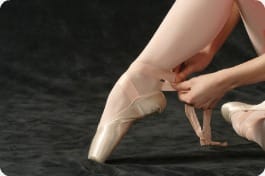Dance Teacher Certification

Foreign languages are often referred to as languages of love. Music, too, is an easy way to communicate across languages. But perhaps nothing is as universal in its ability to express emotion, beauty, and grace as dance.
From ballet to tap, and from acrobatics to jazz, each type of dance has its own rhythm, style, and rich history. Tomorrow’s Baryshnikovs, Gene Kelleys, and Fred Astaires spend countless hours over many years learning the steps, tempos, and nuances of the perfect dance performance, often from certified dance instructors.
On This Page…
| The role of certified dance teachers |
| A variety of options… |
| Teaching ballet in schools |
| Private dance studios |
| Why does dance matter? |
| Getting Certified |
| Find Schools offering teaching certification programs |
For dancers who never established themselves professionally or had to drop their pursuit of their dreams due to age or injury, becoming a certified dance instructor provides a way of staying connected to the art form. Though they’re not performing, certified dance instructors get to pass on their passion and knowledge of their craft to the next generation of dancers in private dance academies and often in public schools.
The role of certified dance teachers
For many dance teachers, a long career or lifetime of study of the art is enough to propel them into a new career as a teacher. But for those without direct teaching experience or who are seeking a competitive edge in the dance market, earning a dance teacher certification is a wise choice.
- Dance composer/choreographer
- Professional dancer
- Middle school, high school, collegiate dance class teacher
- Consultant for dance competitions, television shows, movies
- Dance therapy
A dance teacher certification is a simple way to earn recognition from students and colleagues in the workplace. Instructors who have a dance teacher certification have a leg up on other dance teachers who do not. A dance instructor certificate program provides specific training in the general principles of expressive movement and movement specific to various forms of dance, including modern, jazz, tap and ballet.
But a dance teacher certification is more than just moving and dancing. Teachers pursuing certification explore various age-appropriate ways to communicate important dance techniques such as alignment to students. At the same time, they’re immersed in ongoing choreography and lesson plan development activities to help better understand how each aspect of a student’s development feeds into the next.
Certification programs are available through a number of private dance membership organizations, as well as a number of public and private colleges and universities. Many dance membership organizations provide both introductory and advanced teacher training workshops that cover nuts-and-bolts information as well as the latest in science, technology, pedagogy, and artistry. But for dance teachers wishing to teach in schools, they’ll need to be licensed to teach, which can be attained with the completion of a bachelor’s degree in education or certification program.
Instructors licensed to teach in schools benefit from flexible career opportunities, as they’re able to work in schools or in private dance studios instead of being restricted to just one or the other. In addition, certified dance instructors qualified to work in schools benefit from the ability to teach students while they’re in school and then transition them to private studios, where teachers are paid directly for their services. Teachers can spend more time working directly with students for greater learning while increasing their earning potential.
A variety of options
Dance teacher certification can seem like a jumble of acronyms. With so many certifying bodies—DEA, DMA, NDEO, RAD, CDTA, Cecchetti USA—the opportunities for earning advanced credentials are nearly limitless. Certified dance teachers have the opportunity to teach privately at dance studios and academies or teach in an academic setting such as a middle or high school.
The certification requirements ensure that instructors don’t just know how to dance, but rather are extremely well-versed in various teaching methods. Certified instructors working in both private studios and public schools need to be proficient in explaining the theory of certain type of dance and then help students break down individual steps to their most fundamental elements to help students recreate the movement patterns on their own.
Teaching Ballet in Schools
Many public and private schools offer ballet classes for high school students. For dancers interested in ballet, the Royal Academy of Dance (RAD) offers a dance instructor certification program designed to create top-flight, in-demand instructors. Patty Ashby, the U.S. national administrator for the Royal Academy of Dance, says that the organization encourages certification and continuous education because simply being trained as a performer doesn’t prepare a dancer for life as an instructor.
RAD’s curriculum is specifically engineered to equip dance instructors with necessary skills and knowledge to work with young bodies and to understand both emotional and physical development within the dance arena.
This sort of education—formal training in child and adolescent instruction from world-renowned experts—is especially valuable in a public or private school setting. A certified RAD instructor is required to work with a mentor, complete modules on business, ethics, dance pedagogy, and human anatomy. This allows for a well-rounded, professional education with specific focus on communicating dance theories and movements to school-aged students in age-appropriate ways.
A ballet teacher in a public school may elect to take students to a dress rehearsal or live ballet performance. The teacher’s dance credentials and connections from their certifying dance school may help them arrange a low-cost or no-cost field trip to the ballet to fit within public schools’ tight budgets.
From the spectator seats, a teacher can point out specific movements and choreography to the class, explaining how it relates to the class’s recent subject matter and enabling students to draw comparisons of their own practice with the execution of professional dancers.
Private Dance Studios
Dance teacher certification also allows teachers to instruct privately, providing able and interested students with more intensive study in a group or practice outside of a group environment. Private dance studios allow students to learn a variety of dance genres that may not be available in a school setting.
Private instruction at a dance studio can help a student catch up with a class’s overall skill level if the student is struggling or lagging behind. Similarly, private instruction can help advanced students continue their development beyond the classroom if the instruction level of a group or school class is not performing at a high enough level.
Teachers instructing in private studios, for instance, have fewer rules they need to follow, which allows them to be more creative with planning lessons. For example, a tap dance instructor working in a private academy may show the class vintage footage of Gregory Hines in Tap or of tap virtuoso Savion Glover in the movie Bamboozled. While students won’t have the skill set to replicate the legends’ moves, a certified teacher will use available video technology in the studio and on students’ home computers to help students break down step-by-step, in slow motion, each of the performers’ choreographed dances to their fundamental elements. Teachers can dedicate an entire class to a re-enactment of those exact steps, providing students ample time and practice to learn basic movement patterns as the foundation, and accelerate the learning curve for adding in dance moves later.
Dance students have a variety of motivations for taking dance classes. For some it may be a school curriculum elective or maybe just a fun way to get some exercise. For others, it’s the first step in a long road toward a career as a professional dancer. In both cases, students both need and want to learn from a seasoned, certified professional who can teach them the finer points of a dance style safely and effectively.
Why does dance matter?
Certified dance instructors can make a significant, life-long impact on children and adolescents. Dance classes led by certified instructors not only offer a safe, encouraging environment for kids, but also provide children and adolescents important developmental opportunities. From the youngest children to volatile teenagers, certified dance instructors demonstrate excellent interpersonal communications skills enabling them to establish an emotional connection with all their students. Dance teachers aren’t just teachers for their students; they’re role models, advisers, confidants, and friends that dance students can rely upon throughout their formative years.
Certified dance instructors are uniquely qualified to devise fun, engaging, and physically demanding dance lessons that challenge students of all abilities to think and move in ways they may not have before. In addition to helping keep kids healthy and strong through demanding physical challenges and allowing self-expression at an emotional level, dance can also improve academic performance and students’ learning abilities.
Emerging studies reveal a substantial connection between movement and cognition, meaning that the more students move, the better they may learn. Dance is a fun way to move and–led by a highly skilled instructor—also a fun way to improve learning. To some students, a certified dance instructor may be just a teacher. To others, they’re lifelong friends, inspirational figures, and the key to a more productive life.
Getting Certified
The cost and processes for a dance teacher certification is as varied as the dance steps themselves. Online certifications are available for as little as $200. However, longer and more intensive programs can cost a lot more.
Many dance teacher certification tests and courses require no qualifications to begin. Some require dance teachers to have prior experience in dance, schooling and a degree to begin training to earn a certificate.
Instructors wishing to teach in schools will need to earn both a bachelor’s degree in education and a specific certification in dance, where available, or earn a bachelor’s degree in theater and dance arts and then a certification in education to be able to teach.
Learn more about teaching certification requirements in your state here.
According to the National Center for Education Statistics (NCES), dance classes and instruction are growing at virtually every level of the United States’ educational system. Recent statistics show that approximately 665 postsecondary institutions offer dance minor or major programs and that nearly 6,000 K-12 schools in the United States offer dance as part of the K-12 curriculum.
With roughly 3.5 million students receiving dance instruction in schools, yet only 7% being trained by physical education teachers and not dance specialists, the opportunity for certified dance instructors to find employment in schools is growing rapidly.
Schools realize that even in the face of deep budget shortages, physical education and the arts are critical factors in early childhood and adolescent education. Dance bridges the gap between these two academic areas, providing students an opportunity to be active for better health and to develop creative skills that have been proven to increase academic achievement in traditional disciplines like math and science.
Earning a teaching license and certification from any of the postsecondary institutions and dance specialty certifying bodies gives professional dancers and dance enthusiasts the chance to become more involved with an ever-challenged educational system, provide a valuable learning experience, and create a fruitful, sustainable, and enjoyable career as a teacher.







